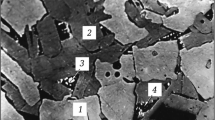Problems of the presence and formation of hexavalent chromium in raw materials and with arc furnace melting are discussed. It is shown that preparation of fusion-cast refractories is possible with provision of safe production conditions.
Similar content being viewed by others
References
V. A. Sokolov and M. D. Gasparyan, “ Fusion-cast chromium-bearing refractories – the most durable materials in aggressive melts,” Ref. Ind. Ceram., 52, No. 2, 146–150 (2011).
B. L. Krasnyi, V. P. Tarasovskii, A. B. Krasnyi [et al.] “Granular-structure chromium-bearing refractories: Properties and uses,” Ref. Ind. Ceram., 49, No. 1, 57–62 (2008).
K. K. Strelov, I. D. Kashcheev, and P. S. Mamykin, Refractory Technology [in Russian], Metallurgiya, Moscow (1988).
N. L. Lyakishev and M. I. Gasik, Chromium Metallurgy [in Russian], ÉLIZ, Moscow (1999).
A. K. Karklit, N. M. Porin’sh, G. M. Katorgin, et al., Refractory Objects , Materials and Raw Materials: Reference Edition [in Russian], Metallurgiya, Moscow (1990).
GOST 12.1.007–76. SSBT. Harmful substances. Classification and general safety specifications, Izd. Standartov, Moscow (1999).
GOST 12.1.005–88. SSBT. General sanitary and hygiene specifications for workspace air. Izd. Standartov, Moscow (1998).
Occupational exposure limit (OEL) for harmful substances in workspace air. Hygiene standards GN 2.2.5.13134–03, Russian Ministry of Health, Moscow (2003)
L. B. Khoroshavin, V. A. Delyabin, V. A. Perepelitsyn, et al., “Hexavalent chromium in refractories,” Ogneupory, No. 9, 7–11 (1993).
GOST 2912–79. Commercial grade chromium oxide. Technical conditions, Izd. Standartov, Moscow (1989).
GOST 12.4.021–75. SSBT. Ventilation systems. General specifications. Izd. Standartov, Moscow (1999).
E. K. Kazenas and D. M. Chizhikov, Vapor Pressure and Composition Above Chemical Element Oxides [in Russian], Nauka, Moscow (1976).
V. A. Ryabin, M. V. Kireeva, N. A. Berg, et al., Inorganic Chromium Compounds: Handbook [in Russian], Khimiya, Leningrad (1981).
N. V. Fedorenko, “Utilization of dust captured during production of chromium and silicon ferroalloys,” Abstr. Inform TsNII and TÉI. Chern. Met. Ser. Ferrosplav. Proizvod., No.1, 14 (1985).
V. A. Sokolov, “Fusion-cast high-chrome refractories synthesized in the Cr2O3–MgO–SiO2 system,” Ref. Ind. Ceram., 46, No. 5, 338–343 (2008).
RHI Group Prospectus “Refractory materials for glass industry.”
SEPR Group Prospectus, “Refractory products for glass furnace. Fused cast refractories.”
Author information
Authors and Affiliations
Rights and permissions
About this article
Cite this article
Sokolov, V.A. Problem of hexavalent chromium in the production of fusion-cast chromium-containing refractories. Refract Ind Ceram 53, 112–114 (2012). https://doi.org/10.1007/s11148-012-9474-6
Received:
Published:
Issue Date:
DOI: https://doi.org/10.1007/s11148-012-9474-6




